Are you an amateur golfer looking for more information? Or are you an expert player seeking updates about the game? Then, this buying guide for the best golf balls is meant for you. This guide provides an in-depth understanding of the essential equipment in golf.For example, do you know why golf balls have dimples?Similarly, if you still don’t know which features are key when buying your gear, then read on. So, are you ready for the learning experience? Let’s get to it!
Golf Ball Basics
Did you know that Golf dates back to 100BC? The first form of Golf is the Roman game of paganica. Here, players used to hit stuffed leather balls with a bent stick. However, the modern game traces back to Scotland (around the 15th century). The key difference being the hole! Older practices didn’t have a hole until the Scottish developed one alongside several rules, some of which are still carried on to date. Enough about the game: Let’s discuss the golf balls.
1.1 The Making of Golf Balls
Making of golf balls has evolved for centuries. Ancient golf balls had distinct differences. Hence a one-piece golf ball was quite different from a two-piece one and so on. Then, in the 1900s, golf balls were much smaller compared to the modern-day golf balls. Also, the balls for American tournaments were not suitable for European competitions. Making of golf balls unfolded depending on the historical era as follows: –
The game of golf emerged in the 1400s in Scotland. During this time it was the peasants that curved out golf balls from wood. Then, 1600 saw the emergence of leather golf balls. These were simple triple-layered leather sacks filled with goose feathers. The filling had to be wet so that they shrink into the right size. Then when the feathers dry, they expand into the leather cover, giving the golf ball a smooth round shape. The shells had a painted outer finish. Making the leather golf balls was time-consuming and tedious. Still, they were an improvement of the wooden golf balls. These balls could achieve a decent flight and last longer than the wooden golf balls.The third prominent era in the making of the golf balls was in the 1800s. During this time, the first rubber golf balls came to be. Nicknamed Gutties, these golf balls were the first mass-produced batch. Making of these balls consisted of heating and pouring rubber into molds.
Then, the balls makers hit them using hammers to achieve small dents that gave the balls a much distance. It is these dents that later evolved to dimples. Rubber is still a favorite material for making golf balls today.
The modern-day golf balls are of rubber or synthetic cover and molded core. They have layers that vary according to the intended hardness. Other golf balls use Surlyn, thermal plastic, or urethane for their nucleus. Manufacturers inject this core filling using modern technology. Also, the outer cover is hard and dimpled. Finally, the craftsmen paint the logo or brand name on the surface of the ball before applying a final coat. These balls are of superior performance. They vary in size, construction, spin, compression, and feel. Different golf ball brands also add their styles to appeal to their target players. The next section will explore all these aspects of the modern golf ball.

1.2 What Is The Standard Size Of A Golf Ball?
As per the USGA and the R&A rules of golf, a typical golf ball should not be smaller than 42.67mm in diameter. Its circumference is under 134.058mm. Furthermore, the width and height should be less than 43mm. The golf ball’s weight remains below 1.620 ounces. Its initial velocity is also less than 250 feet per second. These balls’ carry and roll range should not exceed 280 yards.
Golf balls feature dimples measuring 0.01 inches deep. A standard golf ball will have between 250 and 500 dimples. These also have a part to play in improving the player’s performance. Check out the FAQ section for an in-depth explanation on this.
Why are these numbers relevant to a beginner, average, or expert golf player? Well, the golf ball market is full of a variety of construction designs to suit the different players. It’s only wise that each player should use these standard parameters act as the threshold. This way, the player has a check that ensures he doesn’t compromise his performance for style. What then are these golf ball construction styles? Let’s explore this next.
1.3 Golf Ball Construction
Golf ball construction refers to the style and material of the golf ball. This aspect is what determines its trajectory or flight path dynamics. For example, the pioneer golf balls made of wood could only travel up to 100 yards. Today, the Guinness world record for the longest drive is 515 yards. This drive was in a PGA competition. How cool is that? Both the style and materials used will detect how the ball will respond to the club. Here is a list of the most common golf ball constructions available today: –
1.3.1 One-Piece Golf Balls
Are you a beginner golfer? Then the one-piece golf ball is a primary, durable, and inexpensive gear suitable for you. Also, this golf ball works well for players on crazy-golf courses or driving ranges. A one-piece golf ball is of a firm Surlyn and mold-in dimples. Due to its general soft feel and low compression, it rarely gives the player much distance when hit.
1.3.2 Two-Piece Golf Balls
A two-piece golf ball is of a rigid resin or acrylate and a tear-resistant cover. This two-layer design is hard and durable yielding most distance for the player. Still, this ball is quite cumbersome to control. Hence, it is popular with regular golfers who want to improve their skills of the game.
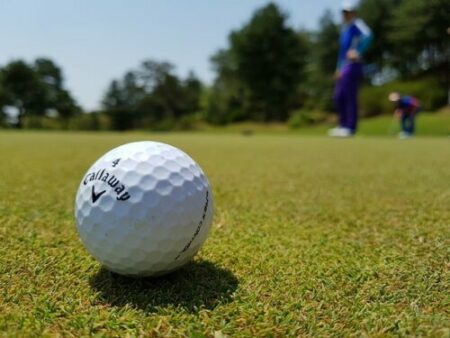
1.3.3 Three-Piece Golf Balls
Three-piece golf balls have a soft feel with a more prominent spin. Besides, they offer the player better control of the ball. The shots give the player a competitive spin-separation power. These golf balls comprise of the following triple stripes: –
- A liquid or compact rubber core;
2. Middle improved rubber or liquefied layer and;
3. A Urethane, Surlyn, or Balata cover.
1.3.4 Four-Piece Golf Balls
Every extra layer on the ball customizes it for better play and spin-separation. Indeed, the first layer has a firm rubber to cover the longest distance. The ball’s second film works to redistribute the energy from the strike. Plus, the third layer achieves a mid-spin that reaches far. Finally, the top most cover is a thin Urethane layer with at least 300 dimples. This four-piece golf ball covers the farthest distance while maintaining the softest texture.
1.3.5 Five-Piece Golf Balls
A five-piece golf ball works like a three-piece or four-piece golf ball. Also, its superb spin separation guarantees superior performance on the green. Besides, such balls achieve the longest distance. This superior construction retails in Pro Shops at premium rates. It is no wonder that these golf balls feature in major tournaments.
A five-piece golf ball offers the following layers for optimal performance: –
- An inner core for high speed;
- Triple mantle layers for the best shots and swings and;
- An outer urethane cover with a soft feel.
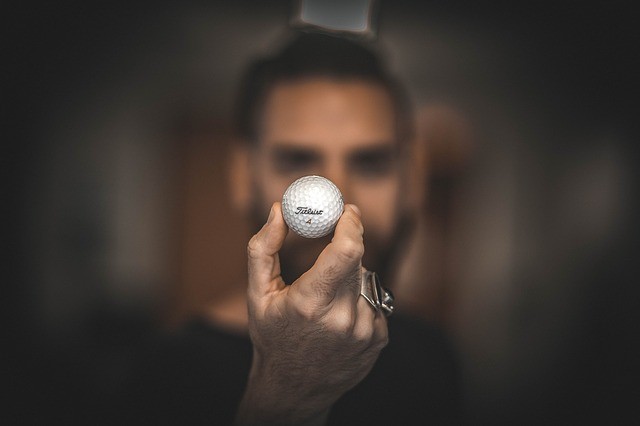
1.4 The Spin
A golf ball’s spin refers to the way the shots land on the green. It is how the ball bounces before settling on the green. The spin assists to keep the golf ball on firm greens. Hard pins become accessible depending on your spin style. Also, the players use this technique to increase their chances of setting up a short birdie.
A golf ball can spin in three ways. It moves in topspin when the upper side faces the direction of the throw. In turn, the underside spins while facing the player. This seamless style achieves a swift ball release when it lands.
Sidespin happens when the ball curves either to the left or right mid-air. Indeed, it is impossible to strike a ball that has a zero sidespin. That is, even a pro golfer rarely achieves a straight shot. Instead, they opt to perfect a ball flight pattern that suits their game.
Finally, a ball with a backspin rotates towards the player upon hitting it. Such a spin achieves high flying balls. Different golf balls launch differing spins as follows: –
1.4.1 High Spin Golf Balls
A high spinning golf ball has a unique design to achieve the most spin. These golf balls’ backspin has a high trajectory, resulting in a longer carry. Such balls are an excellent pick for players who hit shots from the right with a draw. They have a better feel on the green, hence, greater control for the player.
1.4.2 Low Spin Golf Balls
Unlike the high spin golf balls, low spin golf balls have minimal backspin. They decrease the occurrence of sidespins, resulting in the ball flying at a low height. In turn, such balls travel a short distance in the air. But, they have far-reaching roll when they land. Players who struggle to get a far reach prefer using such golf balls. Also, they work best for golfers who fancy slicing the ball.
1.4.3 Mid Spin Golf Balls
Mid spinning golf balls achieve a stable distance and feel. Hence, they are suitable for most golfers. They work best regardless of the conditions on the green.
1.5 Compression
Golf ball compression relates to the way the ball crushes against the club when hit. It is this impact that dictates how much energy shifts from the club-face to the ball. Indeed, a deeper squash translates to the ball traveling the furthest distance.
Most golf balls have a compression of between 40 and 100. A low compression golf ball is usually softer. So, they are ideal for beginners and high handicappers who grapple with slow swing speed. In contrast, high compression golf balls have a firm feel. They generate a faster swing speed that improves its control.
Note, players should choose a golf ball that matches their swing speed. Otherwise, they risk compromising their performance. For example, a golfer with a fast swing speed will not perform well with a low compression golf ball and vice versa. Still, winter temperatures tend to make the shells unyielding. Hence, a feebler compression golf ball would be ideal.

1.6 Feel/Softness
The construction of the golf ball determines its final feel. For example, a two-piece golf ball has a thick rubber core that results in a firm feel. Such balls go further and last longer. Still, three-piece, four-piece, or a five-piece golf ball has a soft rubber core and a soft urethane cover. This construction trades better control for durability and trajectory. Most low compression golf balls feel soft. In contrast, high compression golf balls tend to be hard due to their multi-layers. Still, their outer cover may seem smooth.
1.7 Golf Ball Brands and Philosophies
Do you know what philosophy your golf ball maker believes? This understanding is critical to all golfers. Each manufacturer makes a golf ball in line with its outlook. This outlook is their view on what aspects matter most to a golfer when fitting a golf ball. For example, Titleist concentrates more on achieving a short-game play. They value the feel of the golf ball above all other features. Bridgestone would first match the ball’s compression to the driver swing velocity. They believe that every player prefers their unique best compression. Once the player finds his perfect golf ball, he/she sticks to that brand. He then works on scores and consistency.
1.8 Other Types of Golf Balls
1.8.1 Lake Golf Balls
Often players make bad shots. They may end up with their golf balls in the lake or pond. Lake golf balls are golf balls that were once in lakes or pond for long. They go through a recycling process to be efficient on the green but at a diminished play.
Are lake golf balls a worthy investment. It depends on the condition of the golf balls and your budget. Balls that have water damage travel the shortest distance. Indeed, a standard golf ball that stays in the water for at least eight days loses at least six yards trajectory. This loss increases to 12 yards for a shell that was in the water for at least three months. Moreover, a golf ball lost in the lake for six months loses 15 yards of trajectory. But, this performance depends on the type of golf ball.
New golf balls are quite expensive compared to lake golf balls. Hence, a recreational golfer opts for lake golf balls instead. Also, beginner players may use lake golf balls as they figure out what works best for them. Recycling companies apply a shiny gloss to the cover, making the golf balls appear brand new. But, this shine may fade with time. This discoloration does not affect the ball’s performance.
1.8.2 X-Outs Golf Balls
X-Outs golf balls new golf balls but with cosmetic blemishes. Such factory overruns sell at a discount but perform the same way as those with no flaws. If you are a player who appreciates quality golf balls but can’t afford them, opts for X-Outs. Search for such shells from pro-level brands.
2. Do Golf Balls Make a Difference?
Yes! Golf balls differ in various aspects, including their trajectory, feel, and spin. Which of these aspects are most critical to you? Players vary in their style and preferences. Thus, always choose a golf ball that matches your style and taste. Then, work on perfecting your game.

3. How to Choose the Best Golf Balls?
Various factors come to play when selecting the best golf balls for your game. Construction, price, player’s skill level, and brand are some of these factors. We’ve already expounded on these features in the earlier sections. How then should you choose the best golf balls for optimal performance? Consider all these features in line with the following extra traits.
- Are you a beginner golfer?
- Do you want to play like a pro?
- Are you male or female?
- Are you a senior?
Let’s explore these four aspects in the next section.
3.1 The Best Golf Balls for Pros
Pro golfers prefer golf balls that offer the best distance. Such balls don’t have many layers and retailing at a premium price. They have two or three layers and of affordable materials. Still, they achieve a decent distance. A two-piece golf ball feels soft and reaches furthest.
Golf balls with a hard shell travel farthest. In contrast, softer ones are easy to control. To tell them apart based on their stiffness, drop them at once. Then observe which of the balls achieves the highest bounce.
Choose a golf ball with a precise dimple pattern. Any Callaway or Bridgestone golf ball’s dimple pattern improves its flight. Also, opt for golf balls with a superior outer surface. Balls with either Urethane or Surlyn outer coating are quite durable.
Next, select a golf ball with fast swing speed. Such balls have low compression, achieving a high squash. An ideal compression ranges between 40 and 100.
3.2 The Best Golf Balls for a Beginner
A beginner golfer ought to get golf balls that give him the right start in the game. What then are the attributes with a competitive advantage for an amateur golfer?
An ideal golf ball for an amateur player should offer consistency in a couple of rounds. Such balls should launch at high energy, have low compression and a soft feel. The low compression enables the ball to roll farthest upon landing on the green. The softness of the ball improves its control. This way, the player will get the longest distance.
A beginner golfer may have poor shots that make him/her lose balls at a high rate. This starting period ends up being costly to the player. Hence, it’s best to start with a low-cost golf ball until he/she masters his game. Affordable choices include one-piece golf balls, lake golf balls, and X-Outs golf balls.
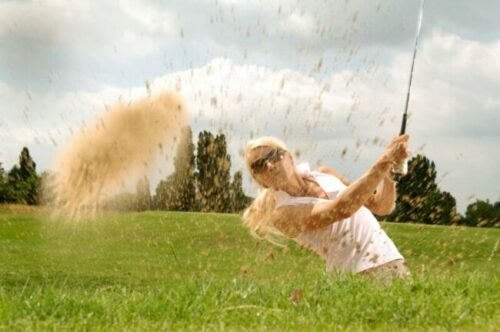
3.3 The Best Golf Ball for Ladies
There is a significant physiological difference between male and female golfers. Also, golf ball makers know this too well. Did you know that a women’s golf ball achieve greater distance than a similar golf ball intended for men? This intentional difference is because on average, ladies have a low swing speed. Indeed, female golfers struggle to hit their ball far or high enough like their male peers. It is their swing speed that limits the ball flight. Also, men’s golf balls are weighty, aiming for high swing speed.
Female golfers need golf balls that offer better control and landing. For example, a two-piece golf ball with at least 300 dimples will enhance the ball’s elevation and landing. Furthermore, female players need golf balls with a good feel. A softball is easy to carry, achieving a great distance. Only, this aspect depends on the golfer’s preference.
3.4 The Best Golf Ball for Seniors
Experienced golfers are often guilty of retaining the same pair of golf balls for years. But, they may have a drop in swing speeds now that they are seniors. Are you guilty of this? It’s time to let go. Pick your next pair of golf balls with the following aspects in mind: –
Distance
An ideal golf ball for seniors should help them to hit a bit further. Opting for senior tees and versatile shafts to suit you is necessary. Also, get a golf ball that achieves the distance.
Durability
A retiree golfer wants to check his/her spending. Hence, the best golf balls here should last for many rounds. Such balls should be able to withstand hard hits. Avoid softballs that develop a smirk on the cover after a few shots.
Spin and Feel
A senior golfer ought to get golf balls that have a stable feel and spin. Indeed, this choice improves his/her chipping and putting. Choose golf balls with good backspin. Also, they should be easy to control around the green. Hence, not all softballs are bad for a senior, after all.
Visuals
Visibility is an essential feature of golf balls for seniors. Opt for a golf ball that has bright color schemes and markings. Such shots are easy to locate in the rough. Indeed, it makes no sense investing in a premium ball when you’ll struggle to find where it lands.
If your eyesight isn’t as it was when you started playing golf, opt for vivid green or yellow balls. Also, you should be able to see these balls as you stand over a putt. Still, stay away from golf balls with shouting logos. Such shells will divert your focus from the hit.
Value
Finally, the best golf ball for seniors ought to give you value for the money. Apart from durability, price is also relevant. Hence, find a balance between a budget and an optimal golf balls. Pick an affordable golf ball with the best performance in its category.
4. Tips for Keeping Your Golf Balls Clean and In Good Condition
Golf balls need proper care and maintenance at all times. Indeed they go through natural wear and tear. Hence, if not kept in top-notch shape, these balls degrade faster over time. How do you get the most out of your golf balls? Ensure they stay clean, stored well, and protected from accidental damage. Here’s how: –
4.1 How to Clean Your Golf Balls
Like most sports equipment, golf balls get dirty with use. Whereas a small patch of dirt is easy to rinse off right at the course, there is still some dirt that remains on the balls. With time, such dirt will accumulate and compromise your game. In contrast, clean golf balls have an aesthetic appeal. Plus, are visible from far, in the sand trap or the rough. We know that wetness affects the performance of golf balls. How then should you clean your golf balls? Below are easy to follow steps to clean your golf balls like a pro at home.
Step 1
Remove off any dirt or mud pile on the ball. Wipe the ball with a robust towel. Or, rinse the ball with fast running water.
Step 2
Have warm water in a bucket or sink. Pour in some liquid detergent. Measure this detergent according to the number of golf balls you intend to clean. Next, submerge the golf balls in this soap solution for about two hours. Then, drain the balls and rinse them with fast running water. Use either a faucet or a hose.
Step 3
Use a dry absorbent towel to get your golf balls dry. Let them continue drying in the shade for several hours.

4.2 Proper Storage for Your Golf Balls
Proper storage protects golf balls for longer. These balls stay off high humidity, extreme heat, and friction with other objects? Here are quick tips: –
- Clean and dry your golf balls before you store them.
- Use a proper storage box, pouch, rack, or bucket to store your golf balls. Only place the recommended number of golf balls per storage area. This way, you avoid crashing your balls.
- Always store your golf balls at room temperature. Extreme heat or cold will compromise your shots and the ball’s performance.
- Keep your golf balls indoors at all times. Avoid storing them in garages with high humidity.
- As you get to your game, limit carrying your golf balls with other sharp objects. These objects may leave unpleasant scratches and dents on the balls.
- Carry only the number of golf balls you think you will need at the golf course. Keep the rest in serene storage at home.
- Never leave your golf balls in the car trunks during the summer season. Temperatures in these confined spaces can rise to 80°C on a hot day.
- Never store a golf ball for more than two to five years, depending on the outer cover material.
4.3 Damage Prevention with Head Covers
A headcover is an essential golf accessory, protecting the golf gear from damage. But, it’s not surprising to find golfers not using this accessory. Indeed, how often do golfers place and later take off the headcover with every shot they make? What difference does a headcover make for a golf ball?
The golf gear is of notable value to golfers. Hence, the headcover is a priceless accessory to protect this buy. Plus, an ideal head cover plays the following roles: –
- Protecting The Golf Balls
Headcovers protect the golf balls from accumulating mud and dirt. They also keep the balls away from harm as you play. And, since most premium balls retail at a high price, its best to make them last longer by protecting them. Hence, always opt for a water-resistant headcover. Such accessories come in handy when there is a sudden shower while on the golf course.
- Makes Your Sports Gear To Stand Out
Headcovers aren’t for damage prevention only. Use these essentials to make your golf clubs and balls stand out. Experiment with some fun ways to make your golf kit appear unique. Indeed, this is how PGA champions pull off a distinct appearance.
But, be careful not to make your carry too heavy equipment that appears shoddy. Such an image is destructive and distracting. It negates the original and most important purpose of the headcover.
- Add Your Personal Touch
Often golfers express themselves through their sports gear. Indeed, a player may customize the headcover using their choice aesthetics. Hence, find out what other accessories the golf ball maker has. Use them to bring out your character in the headcovers.
5. Golf Balls FAQs
5.1 Why Do Golf Balls Have Dimples?
All golf balls have dimples. This design is not an aesthetic point. Instead, these tiny impressions help to lift and drag the ball across the green. Indeed, these are the ball’s wings. It is these dimples that reduce drag against the shell. Indeed, when balls set off, they launch at 120mph. This speed a lot reduces due to air pressure and moisture.
The golf ball’s dimples force the air around the ball to roll and bounce. This movement creates minor air turbulence around the ball. In turn, the ball moves with this turbulence to achieve its highest lift possible.
Golf ball companies make golf balls’ dimples with varying depth, number, and shape. Still, only the quantity of dimples is relevant. An average golf ball has 336 dimples. A golf ball with more dimples flies higher into the air. Still, this high trajectory is at the expense of distance. Indeed, in theory, a golf ball with no dimples travels half the distance by a similar golf ball with dimples.A golf ball doing a backspin lifts better courtesy of its dimples. These dimples may also put a check on too many sidespins.
5.2 How Many Golf Balls Do Pros Carry?
Whereas a golfer can carry 14 golf clubs at a time, there are no standard rules that apply to golf balls. Indeed, the players are free to bring as many shells as they like. If their caddie has space and strength, he can move around with 100 golf balls if he wants to. But, how many golf balls do pros carry?
Most pro-level golfers carry nine golf balls for each round of golf. Others carry extra balls to cater for mishaps along the way. That is if a golfer tends to lose his balls to the lake or pond. Or, if the weather seems like it will rain before the round ends. Still, others may want to use different balls for different holes. Hence, they carry balls according to their style of play.
All in all, a pro golfer should never run out of golf balls while on the green. Indeed, how will he/she play without golf balls? But, as per the rules of golf, should a player run out of golf balls, he can always borrow more balls from another player. A golfer playing in the One Ball Rule tournament must borrow balls like what he wants to replace. Or, they may make their arrangements to get other shells from elsewhere if time allows them to do so.
5.3 Does Water Affect Golf Balls?
Yes. Often golf balls suck up water when they get wet. This wetness reduces the amount of energy that shifts from the club to the ball when hitting it. In turn, it diminishes the golf balls’ performance. Still, this drop depends on the temperature of the water. Also, how long the ball was in the water and the nature of the golf ball.
Note that, it takes at least a day for water to penetrate up to the core of the ball. Also, it is impossible to assess the extent of damage by looking at the shell only. Hence, a player should respond fast to prevent damage.
Conclusion
This in-depth golf balls guide is intended to provide you all the information you need to prepare for your best performance on the field. I hope I’ve done just that. Enjoy your game!

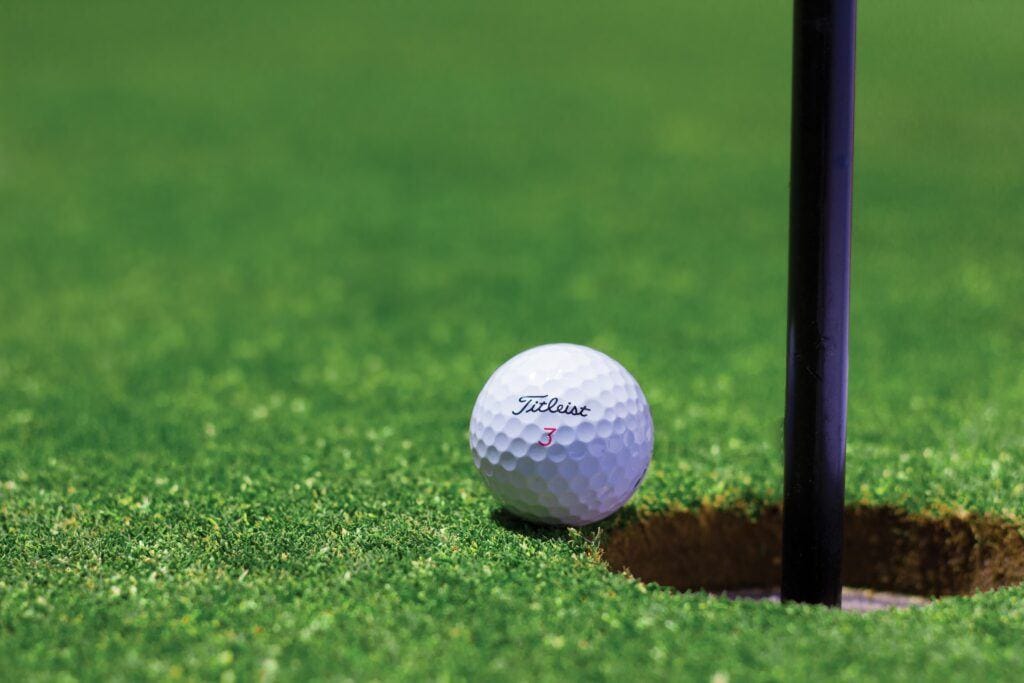


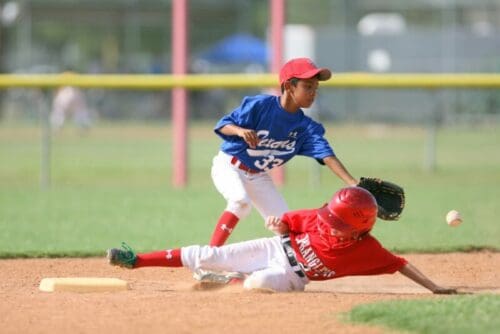
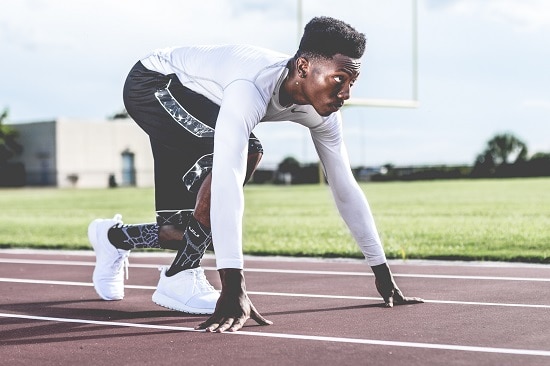
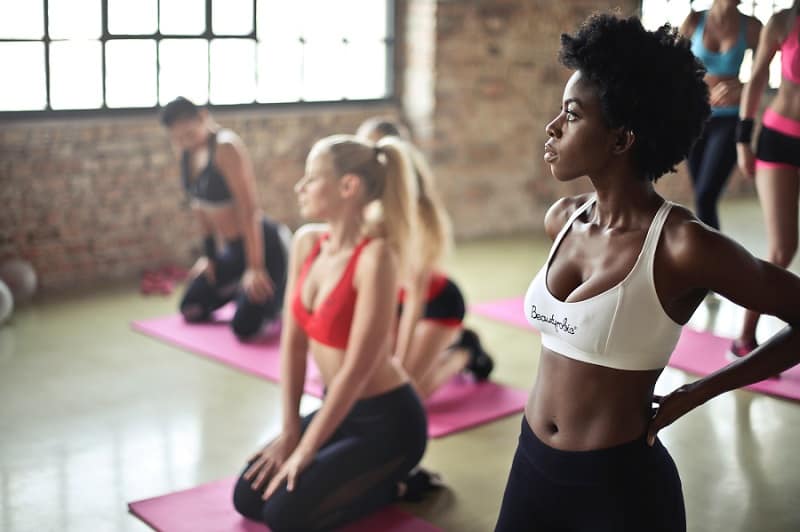
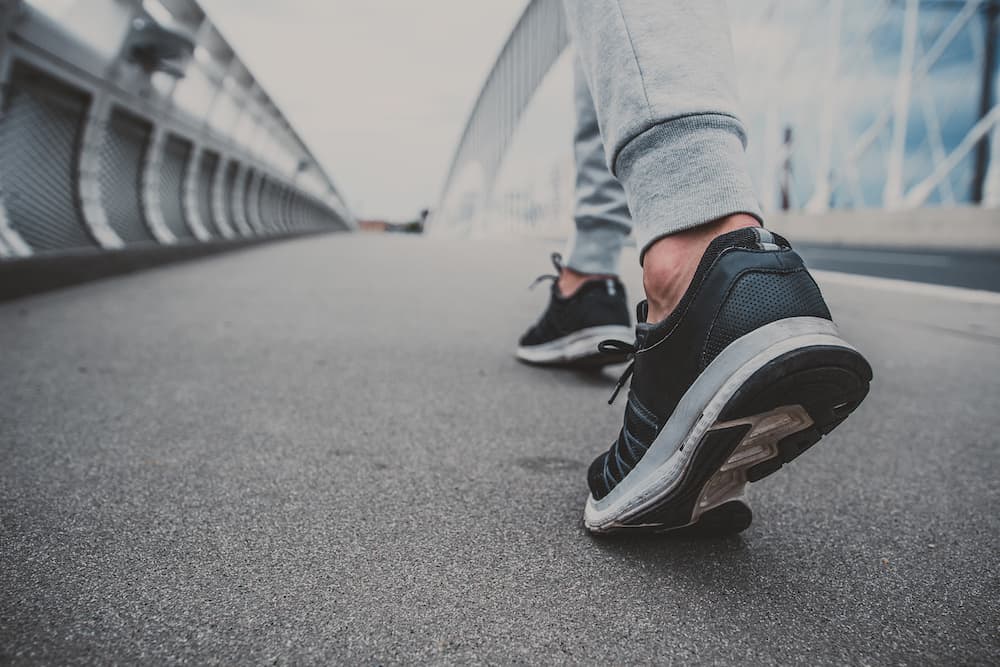






This is quite possibly the most comprehensive overview of golf balls I have ever seen. You go into so much detail! I never knew there were that many different types of balls and so many things to look for depending on your skill level and your desired way of playing. I feel so much more informed now, so thank you so much for taking the time to write this post! I know the next time I watch golf, I’ll be wondering what kind of ball they are playing with!
Hello Steve, and thank you.
Thank you for your kind words.
Great to hear about your benefit of the article too.
Don´t hesitate to contact me if I can help you with anything else, or if you have any questions.
I have been playing golf for over ten years now with this post now I get it why some golf balls like pinnacle tight list and many other different types of golf balls tend to differ in speed and the wat that sound after you hit them. there are golf balls that you cant make a spin with and yet others it’s easy to take a spin however can you tell me what the best golf ball that is used by most professionals is
Hello FatumahNoor, and thank you.
Thank you for your kind words.
The pro uses a different brand. Because like other players, they need to find the balls which fit bets for their strength.
But they need balls with precise dimple pattern as it improves their flight. So balls from Callaway or Bridgestone is trendy.
Too, they need to have low compression balls with fast swing speed.
Such
balls like Titleist Pro V1/1x is an example of great balls for them. I
let the link from Amazon to these balls follow as it is accessible to shipment and useful info about it.
Great to hear about your benefit of the article also.
Don´t hesitate to contact me if I can help you with anything else or if you have any questions.
I had no idea the simple-looking golf ball was so complex. I always thought that they were all made the same, just different colors and name brands. I never imagined that a golf ball would have a liquid center – who knew?
No wonder my husband has been trying so many different brands and has his favorites. So he wasn’t paranoid. He has so many golf balls filling up cupboards in our house. I had better show him this article, especially the part where it says you shouldn’t keep a golf ball for more than two to three years.
Hello Michel, and thank you.
Thank you for your kind words.
Great to hear about your benefit of the article too.
Yes, as your husband has for sure, find out is that the most important is to find the right golf ball home, not necessarily the best because you don´t manage to max the benefit of the best golf balls if you are not a perfect player. I don´t know your husband, but if he is not a good pro, it is more critical for him to find a golf ball that suits his strengths as a player.
Don´t hesitate to contact me if I can help you with anything else or if you have any questions.
I’m not a golfer, but your posting has broadened my horizons. I like to be informed in any field. For me, this is a new domain. I had no idea that golf balls are different for men and women. But one thing I do not understand: if the golf balls are affected by moisture, why clean them by washing?
Hello Carmen, and thank you.
Thank you for your kind words.
Great to hear about your benefit of the article too.
A golf ball that is not clean enough will not keep the speed, and you are too in problem with getting the distance you could plus in it not as accurate as should be.
So with using this method, we recommended we believe it is the best way to clean and dry the ball, included minimal the effects of the moisture. I hope it answers the question.
Don´t hesitate to contact me if I can help you with anything else or if you have any questions.
I’m not a golfer, but my brother-in-law is, and he’s really into golf.
Sometimes when I visit, he has his golf buddies over, and they talk all about golf and golf balls.
I never knew there was a difference, but I learned a lot from them and from reading your article.
It’s interesting to know how they’re their construction is and what makes them fly through the air!
I never asked, but what is the cost of a dozen decent golf balls?
Hello Rob S, and thank you.
Thank you for your kind words.
You can get decent golf balls for around $20-$25.
Great to hear about your benefit of the article too.
Don´t hesitate to contact me if I can help you with anything else or if you have any questions.
I never knew that there were so many different types of golf balls! I always thought there just one standard kind to be used everywhere. I noticed that you said, “Once a player finds his/her perfect golf, he/she will tend to stick to that brand.” So I’m wondering how this plays out in high-level golf tournaments. Do golfers use their ball? Or are all the balls the same to equalize the playing field? If the balls are the same, wouldn’t it be good just to buy golf balls that the tournaments use if you plan on playing tournaments?
Hello Kevin, and thank you.
Thank you for your kind words.
There are, as I explain in the post, a big difference between the balls. And because of it. The most important thing for the golfers is to find the ball which is right for them with their strength and weakness in mind.
Because in many cases, the best balls are not necessary for you as a golfer. So again, finding the right ball, not the best, is the crucial thing!
And for that reason, the players always play with their own balls.
Don´t hesitate to contact me if I can help you with anything else or if you have any questions.
Thank you for this great article. I found the history of golf balls to be very interesting. It must have been very difficult to make golf balls that way when they did not have factories like we do today. I think that you answered every possible question anyone would ever need to know about golf balls! Everything from taking care of the golf balls to what different kinds there are, to the physics of golf balls and more. Thanks for your expertise on Golf, and I hope that more people will find your article.
Hello C, and thank you.
Thank you for your kind words.
Yes, it must have been hard work to manufacture golf balls at the start. And too, we see how incredible big development has been in the science behind the golf balls.
Don´t hesitate to contact me if I can help you with anything else or if you have any questions.
I will be going to golfing in another week, and I was researching golf balls since I know nothing. It was interesting how you wrote everything because I could easily read the article, and a newbie like me was able to understand.
I always had this question as to why golf balls had dimples, and this article explained it so well! I just hope I don’t look stupid the next week when I go to play golf.
Hello, Shrey, and thank you.
Thank you for your kind words.
Great to hear about your benefit of the article too.
I´m sure you will look just great when you play next week! Good luck.
Don´t hesitate to contact me if I can help you with anything else or if you have any questions.
Hi,
Thanks for sharing, a buying guide for the best golf balls. It is precisely what I need since my father retired a couple of years back, he became an extremely avid golfer, but sadly, I know nothing about golf. I thought some new balls would make a nice “stocking filler.” We’re in the UK, so he tends to go away for weekends in Scotland. He’s been playing a couple of years, so guess he’s a novice and needs balls appropriate for wet conditions, any ideas on what I should be looking at?
Hello, Nate Stone, and thank you.
Thank you for your kind words.
Great to hear about your benefit of the article too.
These balls we recommended will all solve the wet condition. But it is crucial to clean the ball after the game. Here are 3 steps I recommended to do after the game.
Step 1
Remove off any dirt or mud pile on the ball. Wipe the ball with a robust towel. Or, rinse the ball with fast running water.
Step 2
Have warm water in a bucket or sink. Pour in some liquid detergent. Measure this detergent according to the number of golf balls you intend to clean. Next, submerge the golf balls in this soap solution for about two hours. Then, drain the balls and rinse them with fast running water. Use either a faucet or a hose.
Step 3
Use a dry absorbent towel to get your golf balls dry. Let them continue drying in the shade for several hours.
Don´t hesitate to contact me if I can help you with anything else or if you have any questions.
Hello, I must say that this article is very helpful and informative. I am a big fan of golf, and it is a great sport. My best friend is a golf trainer, and I am sure he will be surprised to show him this article. I also need to get a few new balls; you give great ideas about which one to chose. Thank you for sharing!
Hello, Danijel, and thank you.
Thank you for your kind words.
Great to hear about your benefit of the article too.
Don´t hesitate to contact me if I can help you with anything else or if you have any questions.
Wow, there is so much more to a golf ball than I realized. I never knew the history of them. I find it fascinating the way the leather golf balls in 1600 were made. I honestly thought that the dimples were for aesthetics and never knew that they actually have a purpose. Really informative and detailed article. Well done.
Hello, Amanda, and thank you.
Thank you for your kind words.
Great to hear about your benefit of the article too.
Don´t hesitate to contact me if I can help you with anything else or if you have any questions.